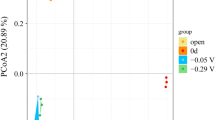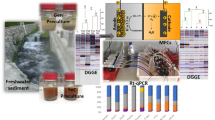Abstract
Increasing attention is being paid to the adoption of photoautotrophic microbes in bioelectrochemical systems (BESs) because of the advantages of self-sustainability. Biased potential on the anode was capable of adjusting the performance of non-photo BESs, and the microbial community structure was also changed; however, few studies have been conducted to investigate the effects of potential on microbial community structure in photo-BESs. In this work, the response of microbial community structure to different potentials (i.e., 0, 0.2, 0.4 and 0.6 V vs. Ag/AgCl) was characterized with 454 pyrosequencing. Four samples were collected and they generated 42865 16S rDNA sequencing reads with an average length of 429 bp. The potential at 0.2 V resulted in the highest current density (378.8 mA m−2) and showed a strong selection for γ-proteobacteria (30.8% of the sequences). α-Diversity analysis showed that microbial diversity increased with increased potential. Rhodopseudomonas palustris was dominant among known exoelectrogens in the biofilm biased at 0.4 V. The results provided an insight into the mechanism of potential regulation on the performance of photo-BESs and changes in microbial community structure.







Similar content being viewed by others
References
Aelterman P, Freguia S, Keller J, Verstraete W, Rabaey K (2008) The anode potential regulates bacterial activity in microbial fuel cells. Appl Microbiol Biotechnol 78:409–418
Ariesyady HD, Ito T, Okabe S (2007) Functional bacterial and archaeal community structures of major trophic groups in a full-scale anaerobic sludge digester. Water Res 41:1554–1568
Bombelli P, Bradley RW, Scott AM, Philips AJ, Mccormick AJ, Cruz SM, Anderson A, Yunus K, Bendall DS, Cameron PJ, Davies JM, Smith AG, Howe CJ, Fisher AC (2011) Quantitative analysis of the factors limiting solar power transduction by Synechocystis sp. PCC 6803 in biological photovoltaic devices. Energy Environ Sci 4:4690–4698
Caporaso JG, Kuczynski J, Stombaugh J, Bittinger K, Bushman FD, Costello EK, Fierer N, Goodrich JK, Gordon JI, Huttley GA, Kelley ST, Knights D, Koenig JE, Ley RE, Lozupone CA, Mcdonald D, Muegge BD (2010) QIIME allows analysis of high-throughput community sequencing data. Nat Methods 7:335–336
Finkelstein DA, Tender LM, Zeikus JG (2006) Effect of electrode potential on electrode-reducing microbiota. Environ Sci Technol 40:6990–6995
Jung S, Regan JM (2007) Comparison of anode bacterial communities and performance in microbial fuel cells with different electron donors. Appl Microbiol Biotechnol 77:393–402
Kannaiah Goud R, Venkata Mohan S (2013) Prolonged applied potential to anode facilitate selective enrichment of bio-electrochemically active Proteobacteria for mediating electron transfer: microbial dynamics and bio-catalytic analysis. Bioresour Technol 137:160–170
Kiely P, Call D, Yates M, Regan J, Logan B (2010) Anodic biofilms in microbial fuel cells harbor low numbers of higher-power-producing bacteria than abundant genera. Appl Microbiol Biotechnol 88:371–380
Lee TK, Van Doan T, Yoo K, Choi S, Kim C, Park J (2010) Discovery of commonly existing anode biofilm microbes in two different wastewater treatment MFCs using FLX titanium pyrosequencing. Appl Microbiol Biotechnol 87:2335–2343
Li C, Ding L, Cui H, Zhang L, Xu K, Ren H (2012) Application of conductive polymers in biocathode of microbial fuel cells and microbial community. Bioresour Technol 116:459–465
Lu L, Xing D, Ren N (2012) Pyrosequencing reveals highly diverse microbial communities in microbial electrolysis cells involved in enhanced H2 production from waste activated sludge. Water Res 46:2425–2434
Mccormick AJ, Bombelli P, Scott AM, Philips AJ, Smith AG, Fisher AC, Howe CJ (2011) Photosynthetic biofilms in pure culture harness solar energy in a mediatorless bio-photovoltaic cell (BPV) system. Energy Environ Sci 4:4699–4709
Quince C, Lanzén A, Curtis TP, Davenport RJ, Hall N, Head IM, Read LF, Sloan WT (2009) Accurate determination of microbial diversity from 454 pyrosequencing data. Nat Methods 6:639–641
Rabaey K, Boon N, Siciliano SD, Verhaege M, Verstraete W (2004) Biofuel cells select for microbial consortia that self-mediate electron transfer. Appl Environ Microbiol 70:5373–5382
Schloss PD, Westcott SL, Ryabin T, Hall JR, Hartmann M, Hollister EB, Lesniewski RA, Oakley BB, Parks DH, Robinson CJ, Sahl JW, Stres B, Thallinger GG, Van Horn DJ, Weber CF (2009) Introducing mothur: open-source, platform-independent, community-supported software for describing and comparing microbial communities. Appl Environ Microbiol 75:7537–7541
Schroder U (2007) Anodic electron transfer mechanisms in microbial fuel cells and their energy efficiency. Phys Chem Chem Phys 9:2619–2629
Torres CI, Krajmalnik-Brown R, Parameswaran P, Marcus AK, Wanger G, Gorby YA, Rittmann BE (2009) Selecting anode-respiring bacteria based on anode potential: phylogenetic, electrochemical, and microscopic characterization. Environ Sci Technol 43:9519–9524
Wang X, Feng Y, Ren N, Wang H, Lee H, Li N, Zhao Q (2009) Accelerated start-up of two-chambered microbial fuel cells: effect of anodic positive poised potential. Electrochim Acta 54:1109–1114
Wang H, Jiang SC, Wang Y, Xiao B (2013a) Substrate removal and electricity generation in a membrane-less microbial fuel cell for biological treatment of wastewater. Bioresour Technol 138:109–116
Wang Z, Zheng Y, Xiao Y, Wu S, Wu Y, Yang Z, Zhao F (2013b) Analysis of oxygen reduction and microbial community of air-diffusion biocathode in microbial fuel cells. Bioresour Technol 144:74–79
Wrighton KC, Agbo P, Warnecke F, Weber KA, Brodie EL, Desantis TZ, Hugenholtz P, Andersen GL, Coates JD (2008) A novel ecological role of the Firmicutes identified in thermophilic microbial fuel cells. ISME J 2:1146–1156
Wu YC, Wang ZJ, Zheng Y, Xiao Y, Yang ZH, Zhao F (2014) Light intensity affects the performance of photo microbial fuel cells with Desmodesmus sp. A8 as cathodic microorganism. Appl Energy 116:86–90
Xia X, Sun Y, Liang P, Huang X (2012) Long-term effect of set potential on biocathodes in microbial fuel cells: electrochemical and phylogenetic characterization. Bioresour Technol 120:26–33
Xiao L, He Z (2014) Applications and perspectives of phototrophic microorganisms for electricity generation from organic compounds in microbial fuel cells. Renew Sust Energy Rev 37:550–559
Yates MD, Kiely PD, Call DF, Rismani-Yazdi H, Bibby K, Peccia J, Regan JM, Logan BE (2012) Convergent development of anodic bacterial communities in microbial fuel cells. ISME J 6:2002–2013
Zhu X, Yates MD, Logan BE (2012) Set potential regulation reveals additional oxidation peaks of Geobacter sulfurreducens anodic biofilms. Electrochem Commun 22:116–119
Zhu X, Yates MD, Hatzell MC, Ananda Rao H, Saikaly PE, Logan BE (2014) Microbial community composition is unaffected by anode potential. Environ Sci Technol 48:1352–1358
Acknowledgements
This work was supported by High Level Talent Program of Xiamen University of Technology (E2015028), the Young Teacher project of Fujian Province (JA15372). Thanks to Dr. Dandie from Flinders University for the careful editing of this paper.
Author information
Authors and Affiliations
Corresponding author
Electronic supplementary material
Below is the link to the electronic supplementary material.
Rights and permissions
About this article
Cite this article
Wu, Y., Zheng, Y., Xiao, Y. et al. Effect of electrode potentials on the microbial community of photo bioelectrochemical systems. World J Microbiol Biotechnol 33, 149 (2017). https://doi.org/10.1007/s11274-017-2312-8
Received:
Accepted:
Published:
DOI: https://doi.org/10.1007/s11274-017-2312-8




